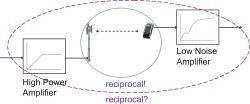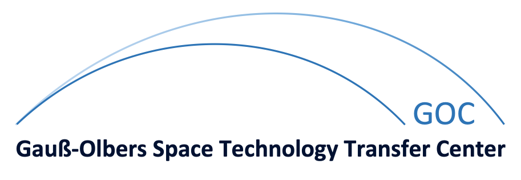Reciprocity in Wireless Communication Systems
The main advantage of TDD systems compared to FDD systems is the possibility to exploit channel reciprocity. If channel reciprocity holds, both transmission links match exactly. Then, the channel estimate of the uplink direction at the transmitter can directly be utilized for link adaptation in the downlink.
Due to the different transceiver circuitries in the transmit and receive path, the reciprocity principle is no longer fulfilled at the digital baseband interfaces.
Objectives:
- Justification and enhancement of hardware structures
- Adaptive correction schemes for enhancements of baseband link equivalence
- Impact analysis and compensation schemes in adaptive transmission
Work Tasks:
- Classification and evaluation of hardware components
- Assessment of effects on adaptive system concepts
- Design of and complexity reduction in calibration schemes
Detailed Description:
To meet the requirements of future mobile communication system concerning high data rate and Quality of Service (QoS) the utilization of adaptive transmit strategies is crucial. Therefore, the smart exploitation and distribution of time, frequency and space resources is an important topic in today's research and standardization activities. The optimization of developed algorithms is strongly dependent on the degree of channel state information (CSI) at the transmitter. A possibility to achieve CSI is the transmission of existing information from the receiver to the transmitter via a feedback channel. However, this causes a degradation of the overall system throughput. Especially in multi-antenna (MIMO) and multi-carrier (e.g. OFDM) systems the amount of necessary feedback to signalize the CSI dramatically increases with the number of antennas and subcarriers. Hence, more efficient approaches to gain CSI at the transmitter are of great interest.
In general, both transmit directions in wireless communication systems are separated via time or frequency duplexing. In Time Division Duplex (TDD) mode the same physical transmission channel is existent for the Forward Link (considered transmission from the transmitter to the receiver) and the Reverse Link (transmission to the transmitter). The question arises how its physical equivalence can be profitably exploited to obtain CSI at the transmitter. If the so-called reciprocity is met, forward and reverse link match such that the estimated channel at the transmitter can directly be used for adaptive signal processing algorithms. As the circuitry components at the transmitter and receiver front-ends differ, the assumed reciprocity of the physical channel cannot be adopted at the interfaces to the digital baseband. Nevertheless, to achieve a preferably good Link Equivalence (similarity of the transfer functions of forward and reverse link) e.g. the calibration of the front-ends by using additional or modified circuitries or signal processing algorithms is conceivable.
 |
The goal of this project is the systematic investigation of this link equivalence and whether adaptive transmit strategies can profit from the utilization of the reverse link. Therefore, a combined analysis and optimization of hardware components and signal processing algorithms is necessary to increase the transmission quality effectively. Coming from a detailed modeling and verification measurements of system components (circuitries of front-ends, antenna characteristics, etc.) the enhancement of hardware structures and the baseband processing is aspired. Based on this knowledge more efficient circuitries and signal processing strategies shall be invented, which consider the imperfect link equivalence in the design or which behave robust with respect to linear or non-linear effects. Depending on the degree of link equivalence different system concepts (single- or multi-antenna, multi-user scenarios, etc.) are investigated and evaluated individually also in terms of different degrees of CSI (instantaneous CSI, long-term channel knowledge, etc.).
Details
Publications
 1 | 2
1 | 2 -
Influence of Non-reciprocal Transceivers at 2.4 GHz in Adaptive MIMO-OFDM Systems
BibTEX

M. Stefer, M. Petermann, M. Schneider, D. Wübben, K.-D. Kammeyer
14th International OFDM-Workshop 2009 (InOWo 09), Hamburg, Germany, 2. - 3. September 2009 -
Calibration of Non-Reciprocal Transceivers for Linearly Pre-Equalized MU-MISO-OFDM Systems in TDD Mode
BibTEX


M. Petermann, D. Wübben, K.-D. Kammeyer
14th International OFDM-Workshop 2009 (InOWo 09), Hamburg, Germany, 2. - 3. September 2009 -
Joint Constellation Extension and Tone Reservation for PAPR Reduction in Adaptive OFDM Systems
BibTEX


M. Petermann, D. Wübben, K.-D. Kammeyer
IEEE International Workshop on Signal Processing Advances in Wireless Communications (SPAWC), Perugia, Italy, 21. - 24. June 2009 -
Improving the Performance of BICM-OFDM Systems in Presence of HPA Nonlinearities by Efficient Bit and Power Loading
BibTEX


M. Petermann, C. Bockelmann, D. Wübben, K.-D. Kammeyer
International ITG Workshop on Smart Antennas (WSA 2009), Berlin, Germany, 16. - 19. February 2009 -
A Multiple-Antenna System for ISM Band Transmission - Calibration Issues and Eigenbeam Measurements
BibTEX


M. Petermann, H. Paul, D. Wübben, K.-D. Kammeyer
13th International OFDM-Workshop 2008 (InOWo 08), Hamburg, Germany, 27. - 28. August 2008
 1 | 2
1 | 2 






